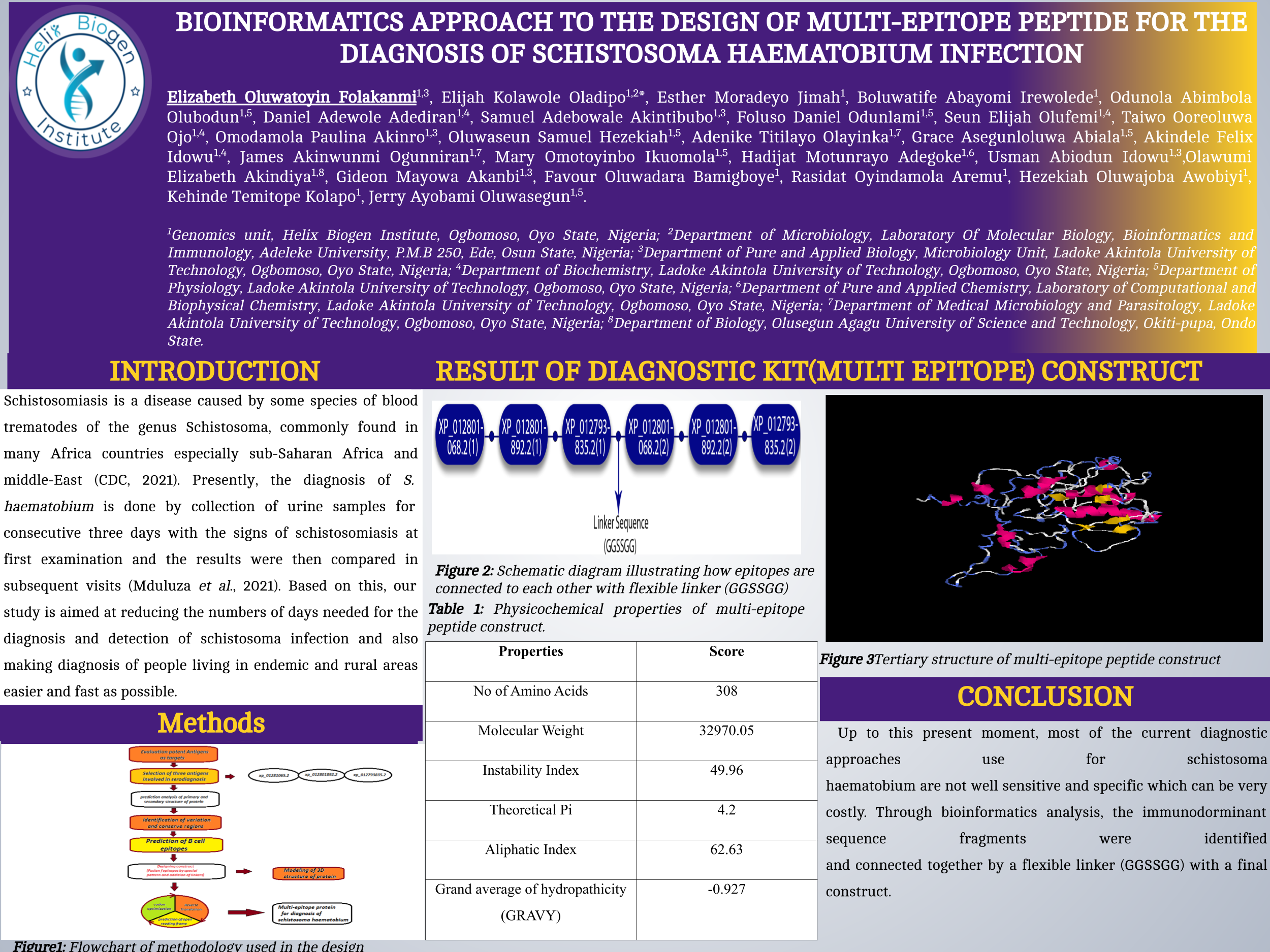Elizabeth O Folakanmi
Conference 2022 Poster Presentation
Project title
Bioinformatics approach to the design of multi-epitope peptide for the diagnosis of schistoma haematobium infection
Authors and Affiliations
Elijah Kolawole Oladipo1,2*, Esther Moradeyo Jimah1, Boluwatife Abayomi Irewolede1, Elizabeth Oluwatoyin Folakanmi1,3, Odunola Abimbola Olubodun1,5, Daniel Adewole Adediran1,4, Samuel Adebowale Akintibubo1,3, Foluso Daniel Odunlami1,5, Seun Elijah Olufemi1,4, Taiwo Ooreoluwa Ojo1,4, Omodamola Paulina Akinro1,3, Oluwaseun Samuel Hezekiah1,5, Adenike Titilayo Olayinka1,7, Grace Asegunloluwa Abiala1,5, Akindele Felix Idowu1,4, James Akinwunmi Ogunniran1,7, Mary Omotoyinbo Ikuomola1,5, Hadijat Motunrayo Adegoke1,6, Usman Abiodun Idowu1,3,Olawumi Elizabeth Akindiya1,8, Gideon Mayowa Akanbi1,3, Favour Oluwadara Bamigboye1, Rasidat Oyindamola Aremu1, Hezekiah Oluwajoba Awobiyi1, Kehinde Temitope Kolapo1, Jerry Ayobami Oluwasegun1,5.
1. Genomics unit, Helix Biogen Institute, Ogbomoso, Oyo State, Nigeria.
2. Department of Microbiology, Laboratory Of Molecular Biology, Bioinformatics and Immunology, Adeleke University, P.M.B 250, Ede, Osun State, Nigeria.
3. Department of Pure and Applied Biology, Microbiology Unit, Ladoke Akintola University of Technology, Ogbomoso, Oyo State, Nigeria.
4. Department of Biochemistry, Ladoke Akintola University of Technology, Ogbomoso, Oyo State, Nigeria.
5. Department of Physiology, Ladoke Akintola University of Technology, Ogbomoso, Oyo State, Nigeria.
6. Department of Pure and Applied Chemistry, Laboratory of Computational and Biophysical Chemistry, Ladoke Akintola University of Technology, Ogbomoso, Oyo State, Nigeria.
7. Department of Medical Microbiology and Parasitology, Ladoke Akintola University of Technology, Ogbomoso, Oyo State, Nigeria.
8. Department of Biology, Olusegun Agagu University of Science and Technology, Okiti-pupa, Ondo State.
Abstract
Background
Schistosoma haematobium has been identified as a major cause of urogenital disease, as well as a risk factor for bladder cancer. The parasites enter the host transdermally either by swimming or wading in contaminated freshwater. The organisms infect the vasculature of the gastrointestinal or genitourinary tracts where they lay eggs that become embedded in the bladder wall, causing chronic immune-mediated disease and the growth of squamous cell carcinoma.
Methods
Proteins specific for schistosoma haematobium are retrieved from National Centre for Biotechnology Information (NCBI). These three protein epitopes were then predicted using Bcpred and Bepipred servers of which the epitopes with the high threshold were selected and concatenated by a flexible linker, forming the proposed construct of the diagnostic kit. Post evaluations were conducted on the multi-epitopes construct to determine the level of it effectiveness such as: the physiochemical (primary) structure prediction using the ExpassyProtparam tool, secondary structure prediction using the SOPMA server and the tertiary structure of the construct were predicted using I-TASSER server.
Results
Sixteen proteins were retrieved from National Centre for Biotechnology Information (NCBI) of which three schistosome(egg) proteins: XP-012801068.2, XP-012801892.2, and XP-012793835.2 were used for the design, after undergoing several bioinformatic analysis such as predicting the antigenicity, searching for all hypothetical transmenbrane proteins and the signal peptide prediction. The result of the post evaluation analysis shows that the diagnostic kit construct is a stable molecule.
Conclusions
The bioinformatics analyses revealed that the constructed multi-epitope peptide has the potential to provide a theoretical foundation for the development of a Schistosoma haematobium diagnostic kit.

